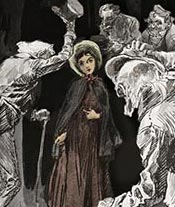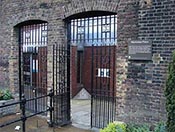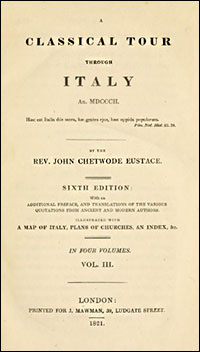The Charles Dickens Page
Charles Dickens'
Little Dorrit
Little Dorrit - The Marshalsea Revisited
Little Dorrit - Published in monthly parts Dec 1855 - June 1857
Illustrations | Locations | Characters | More | Shop for the Book | Shop for the Video
In his eleventh novel, illustrated by Phiz and published by Bradbury and Evans, Charles Dickens' childhood memories of his father's imprisonment in the Marshalsea debtor's prison are brought forth again as the centerpiece of the story of William Dorrit, whose family is also imprisoned there.
Dickens sets the novel in the 1820's, around the time his father was an inmate in the Marshalsea (Little Dorrit, p. 1), but virtually ignores that time period during the novel to address issues that relate to the 1850s (Davis, 1999, p. 215). The theme of imprisonment, both physical and psychological, carries throughout the novel.
Dickens notes in the preface for the completed novel that he had never had so many readers, indeed, sales of the monthly installments topped both Bleak House and David Copperfield (Slater, 2009, p. 407). Critic's responses to the novel were mixed with some saying that Dickens should stick with comedy rather than political satire (Kaplan, 1988, p. 340). George Bernard Shaw called the book "more seditious than Das Kapital" (Laurence and Quinn, 1985, p. 51,64 as cited in Schlicke, 1999, p. 341).
This book, along with its predecessor, Hard Times, marked a turn in Dickens' writing toward a darker and gloomier outlook on life.
Complete List of Characters:
Character descriptions contain spoilers
Little Dorrit Links
The Victorian WebBartleby.com
Bibliomania
Wikipedia
Little Dorrit
Further Information
The Marshalsea Prison
It is curious that in the thirty years since his father was imprisoned there Dickens seems not to have visited the site just across the Thames. He found that 'the front courtyard, often mentioned [in the story], metamorphosed into a butter-shop' and the former walls and blocks of the prison assimilated into the neighborhood.
Charles Dickens' readers were not aware of his intimate relationship to the prison, the story of his father's imprisonment there not being told until his first biographer, John Forster, revealed it after Dickens' death in 1870 (Forster, 1899, v. 1, p. 22-39).
At the beginning of Book the First, Chapter 6 of Little Dorrit Dickens introduces the reader to the prison:
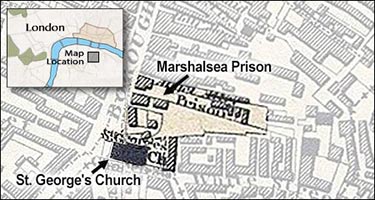
The Marshalsea Prison of John Dickens and William Dorrit 1811-1842
The medieval Marshalsea Prison dated from the 14th century. In 1811 the decaying prison was torn down and a new Marshalsea was built a few blocks further down Borough High Street. This was the prison in which Dickens' father was incarcerated in 1824 and to which Dickens sent William Dorrit in Little Dorrit (White, 2016, p. 177-178).
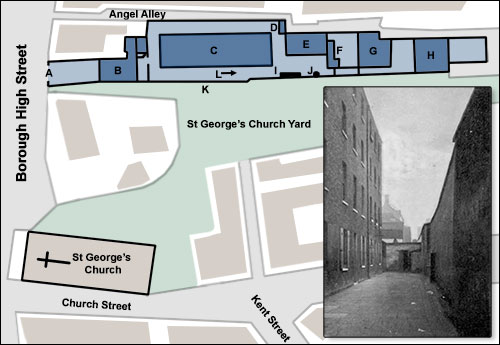
Key:
A - Gate
B - Keeper's House and lodge
C - Block of eight back-to-back four-storey houses containing 56 rooms for debtors. The average room was 10 feet 10 inches square containing one window.
D - Privies
E - Suttling House which included a day room and an ale room and bar
F - Wash House
G - Admiralty Prison used by the navy to house sailors convicted of crimes at sea. When empty it was used as overflow for debtors.
H - Chapel
I - Cistern
J - Pump
K - Remaining wall of the Marshalsea.
L - A photo taken from this vantage point is shown in the inset. The photo was taken in 1897 after the prison had closed and the former prisoner barracks on the left were used to house poor families. The wall on the right, having been shortened after this photo was taken, can still be seen today.
Amy Dorrit and Maggy outside the Marshalsea gate. the church of St George the Martyr looms behind.
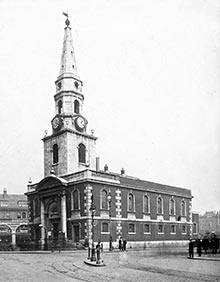
St George the Martyr church in 1910.
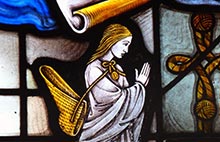
Little Dorrit immortalized in the stained glass window in the St George the Martyr church.
St George the Martyr Church today
Debtor's Prison
The theme of the debtor's prison is central to several of Charles Dickens' novels and to his personal life as well. In 1824, when Charles was 12 years old, his father was arrested for debt and imprisoned in the Marshalsea debtor's prison in Southwark. His father's imprisonment, and Charles' subsequent consignment to Warren's Blacking factory to help support the family, was an extremely traumatic experience that young Dickens never got over, and which proved to be a major influence in his life's work (Forster, 1899, v. 1, p. 20-27).
Typically, a debtor was accused by the person to whom money was owed. The accused was held several days in a sponging house, such as Coavin's in Bleak House or Moss's, in which Rawdon Crawley is held in Thackeray's Vanity Fair. If, in a few days, the money cannot be raised, the debtor is imprisoned until the debt is paid (Wikipedia).
There were three prominent debtor's prisons in London: The Fleet, where Mr. Pickwick (Pickwick Papers) was held, The King's Bench, where Micawber (David Copperfield) was an inmate, and the Marshalsea, where Dickens' father was imprisoned, as well as the fictional William Dorrit (Little Dorrit).
John Chetwode Eustace
A Tour Through Italy (1802)
Mrs General uses Eustace's text to guide the Dorrits on their classical tour through Italy (Little Dorrit, p. 612). The Dorrit's European tour draws heavily on Dickens own travels through France to Italy in 1844/45 and chronicled in his travel book, Pictures from Italy.
Circumlocution Office
Charles Dickens' satiric representation of the Civil Service, where the Barnacle family demonstrates how to go around in circles, spewing red tape, and accomplishing nothing, draws on recent government bumbling during the Crimean War (Little Dorrit, p. xvii)...and perhaps just a hint of leftover cynicism from Dickens' days as a young parliamentary reporter.
 Little Dorrit (2008)
Little Dorrit (2008)
Claire Foy, Matthew Macfadyen
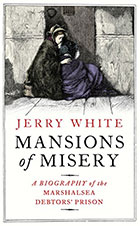 Mansions of Misery: A Biography of the Marshalsea Debtors’ Prison
Mansions of Misery: A Biography of the Marshalsea Debtors’ Prison
by Jerry White
For Londoners of the eighteenth and nineteenth centuries, debt was a part of everyday life. But when your creditors lost their patience, you might be thrown into one of the capital’s most notorious jails: the Marshalsea Debtors’ Prison.
Flora Finching - An old flame revisited

In 1830, when Charles Dickens was 18 years old he fell madly in love with the daughter of a successful banker, Maria Beadnell. He courted Miss Beadnell for three years, although her parents objected to the relationship and the courtship ended with Dickens heartbroken (Slater, 2009, p. 33-39).
Dickens never forgot Maria, Dora Spenlow in David Copperfield was based on his memory of her (Davis, 1999, p. 23).
In 1855, with his marriage to Kate breaking down, Dickens received a letter from Maria, now married and describing herself as "toothless, fat, old and ugly" (Ackroyd, 1990, p. 729) Dickens memory of Maria would not allow him to believe this description and, after several passionate letters were exchanged, a meeting was arranged. When Dickens met Maria he was devastated, her description of herself being fairly accurate. Thereafter his few letters to her were short and formal.
Dickens used the new Maria as the basis for Flora Finching, Arthur Clennam's former lover in Little Dorrit. Flora is fat and tiresome, although sincerely good natured. Dickens would later write "We have all had our Floras, mine is living, and extremely fat" (Schlicke, 1999, p. 35).
The Wisdom of Mr F's Aunt
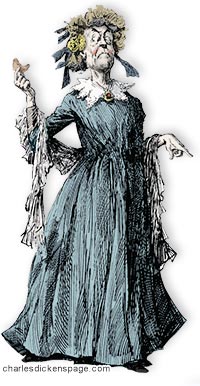
Mr F's Aunt after an illustration by Henry Furniss 1910
A Tour Through Italy
John Chetwode Eustace
A Tour Through Italy (1802)
Mrs General uses Eustace's text to guide the Dorrits on their classical tour through Italy. The Dorrit's travels draw heavily from Dickens' own travels through Europe in 1844-45 and chronicled in his travel book Pictures from Italy.
Charles Dickens' life during the serialization of Little Dorrit
Dec 1855 - Jun 1857Dickens' age: 43-45
December 1855
310,000 handbills and 4000 posters had been printed by Dec 31 advertising Little Dorrit. Sales of the early numbers were phenomenal and continued strong throughout the run (Patten, 1978, p. 251).
March 1856
Purchases Rochester mansion Gads Hill Place for £1790 (Johnson, 1952, p. 870).
April 1856
Returns from Paris where he had been, except for frequent trips back to London, since October 1855. While in France he had completed arrangements for a published translation of all of his books into French.
October 1956
Making preparation to stage the Amateur Theatrical The Frozen Deep (Slater, 2009, p. 413).
May 1857
Visits the site of the Marshalsea prison, where his father had been imprisoned for debt in 1824 and a setting for Little Dorrit (Slater, 2009, p. 424).
June 1857
